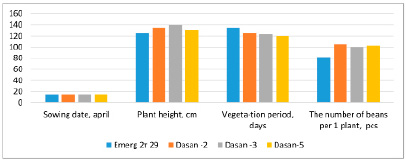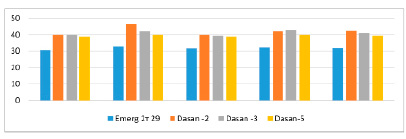Nowadays, there are fears that everything is possible, it is likely that they will not grow and produce the amount of crops that may constitute the nutritional need in the future of the population of all countries of the world that play a role as fodder and nutritional food value [1]. After all, there is a shortage of food in the world. One of the main tasks of the development of the economy is cultivation of crops that require high productivity, containing vegetable protein in large quantities. In its botanical, biochemical meaning, soy is a leguminous crop containing a large amount of proteins, fats and carbohydrates.
And in order to improve the collection of the most productive soybean species, first of all, it is necessary to study some morphological features of this legume, namely growth, development, yield and some parameters of the biochemical composition. Only by studying and examining these features the significance of this culture can be ascertained. Popularity is found in the fact that it contains a large amount of protein, fat and cholesterol. It is noted that this crop is of great importance as the strongest nitrogen fixer in the air, a “producer” of vegetable protein, the content of which in seeds can reach 40% or more [2].
In our country, attention is given to soybean as a plant that solves the problem of fodder and vegetable proteins. The plant has a number of meanings in the food, feed, food and other industries. For example, the main primary products of soybean processing are soybeans, which can be used in food production.
The latest FAO data showed that soybean production in Asian countries is about 10.9% of world production [1]. Our research showed that 2800 hectares were sown with soybeans in Chui region in 2019 year. Whereas in 2008-2009 y. sown area was 100-150 ha. In the span of a decade, there has been a rapid leap in the expansion of soybean acreage. The products of its processing began to satisfy the population of the country. There are a number of reasons for growing it in our republic. For example, in our country there is an acute problem of lack of not how much animal protein, but how much vegetable protein. Meat protein can be replaced with soy protein, as their biological value is the same. World agricultural practice has proven that soy is one of the most important sources of protein in the world. Soybean fats are considered high quality, as they contain a high percentage of oleic and linoleic fatty acids [3]. The fats in soybean seeds contain about 20% of the dry matter. Worldwide, 33% of dietary protein is obtained from pulses. The protein content in a soybean bean averages about 40%, and the oil content is about 20%. Soybeans and peanuts provide 35% of the world’s vegetable oil. Soy proteins may well replace animal protein. The amino acid composition of soy proteins is not inferior to animal proteins, which is confirmed by the data of the World Organization. The level of its use as food is increasing every year. And it’s not a secret for anyone that soybeans are cultivated in the leading countries of the world. In our republic, there is a rather high level of consumption of animal meat for food, which in large quantities leads to an increase in cholesterol levels. The components of soybean have a positive effect on human health. This is due to the presence of glycerol present in the protein, which helps to reduce cholesterol levels in human blood. In view of these reasons, in our republic, soybean will surpass other legumes among other crops in the future, as it is one of the promising crops that has a multi-purpose use, namely: it can be used as food, feed, milk, industrial materials. But as far as our study is concerned, phenological data and other general characteristics were considered. In the work done, the goal is to clarify the characteristic features of the soybean legume in Chui Valley of the country. This will allow you to put forward the best varieties among the test subjects in terms of their growth characteristics.
Research objectives:
- characterize the grown and tested soybean varieties,
- determine some soybean parameters,
- show its economic importance for the country.
Materials and methods of research
The research was carried out in 2018 in the city of Kant of the Chui Valley from April to October. We took varieties: American Emerge 2t29, Korean varieties Dasan-2, Dasan-3, Dasan-5.
Soybean varieties were sown by randomization to identify the best of some soybean varieties in four repetitions. The area sown with this crop occupied 210 square meters. Agrotechnical methods and sowing dates are chosen taking with considering conditions of Chui valley. Before sowing, the predecessor of soybean was a vegetable crop. During the entire growing season, the main soybean phenological phases were observed. Some parameters of each variety were measured: length and width of seeds; counting the number of beans, baskets on one plant, the mass of soybean grains. If we take the length, then we measured from the top to the bottom and the width from the left edge to the right with a caliper.
Results of the research and discussions
It is noted that the growth and development of plants are important processes that consume resources, products and product quality. An irreversible increase in size and mass is the growth of plants, which is associated with damage to the structures of the body. It is formed from cells, tissues and organs. Qualitative changes in the structures and functions of plants – the development of plants. The conditions for the rhythm of growth and development are the environment and the biology of varieties.
Soybean is a short day plant. And its vegetative period varies depending on the type of variety. Our studies have shown that soybean varieties on the experimental plot correspond to the following sizes: Emerge 2t29 – 120-125 cm, Dasan 2 – 135-140 cm, Dasan 3 – 130-140 cm, Dasan 5 – 125-130 cm.
Many distinguish the main phenological phases of soybean development. There are possible stages of organogenesis: 1st stage – seed germination, 2nd stage – seedlings, where the first true leaf and rudiments of branching accumulate, 3,4,5th stages – branching, 6-7th stages – formation of buds and flowers, 9-10th stages – the end of the formation of flowers and the beginning of the formation of seeds and beans, 11-12th stages – the stage where seeds are formed and ripen.
Research experience has shown that the first sunrises appeared on the 7-8th day after sowing. The vegetative parts were the sum of the incidence of small hairs. Flowers develop in all leaf axils, of which 0-5 pods are found per node with 1-5 seeds per pod.
The bean is formed from the following processes – the formation of a seed, the growth of the pericarp, the maturation of the fetus. It is noted that different parts of the fetus grow at different rates and at different times. For example, in legumes, at first, the pericarp grows very quickly, and the seeds grow slowly, then its growth is inhibited, and the growth of seeds accelerates, and the seeds occupy the entire cavity before maturation [4]. Seeds vary in shape and size. But in general they are oval in shape and consist of an embryo that is surrounded by a seed coat. Below in the table, the characteristics of beans, grains are given. Of these varieties, according to the mass of grains, according to the number of beans, the leading places are occupied by Dasan 2, Dasan 3 – Korean varieties.
Based on the data in table, soybeans were taken to accurately measure their values, which are shown below in figure 1.
In the course of the study, the prospects of its cultivation, its distribution throughout the republic and its suitability for food were revealed. The research results are shown in table, figure 1-3. Data showing the timing of sowing, the duration of the growing season, the number of beans on the plants.
According to some researchers, the most important morphological feature of soybean plants, which determines the efficiency and possibility of mechanized harvesting, is plant height [4].
Characteristics of soybean varieties according to some characteristics, 2018
|
№ |
Variety |
Weight of 1000 grains, g |
Number of beans per 1 plant,pc |
Length of beans, mm |
Bean width, mm |
|
1. |
Emerge 2t 29 |
140-150 |
82 |
5-8 |
5-6 |
|
2. |
Dasan -2 |
165-175 |
105 |
6-8 |
5-6 |
|
3. |
Dasan -3 |
165-170 |
100 |
5-8 |
4-6 |
|
4. |
Dasan -5 |
160-165 |
103 |
5-7 |
4-6 |

Fig. 1. Measurement of dimensions (length and width) of soybean varieties
The data of the table, figures give grounds to conclude that the conditions of the Chui region (northern region) are favorable for some species that require full and final development showing physiological ripeness (on average 150-170 days). The most favorable dates were the days of April, and our soybean varieties were sown on April 15, 2018. The favorable temperature for soybean sowing is +15 °С and +20 °С. Timely sowing is an important factor. With early sowing, the surface layer of the soil is cold, as a result of precipitation it becomes hard, which leads to incomplete germination of seeds. And if you sow late, then the soil dries quickly and needs additional watering.

Fig. 2. Research results, 2018 y

Fig. 3. Yield results for four repetitions, centner/ha
The determining factors in the process of formation of the final product are the generative organs of agricultural crops according to the phases of growth and development for the yield of cultivated crops [5]. Yellowing and falling leaves are a sign of maturation, where the harvest begins. The beans are dyed dark. Typically, the moisture content of ripe beans is 12-16%, and for its storage it should be 12-14%. All 4 varieties are close to each other in terms of yield. They differ only in maturity. And the average yield is 31.6 hectares for Emerge 2t29 and 40.9% for Dasan 2, 3, 5. Also, figure 3 shows us varieties from Korea that have special quantitative data.
Conclusion
Nowadays, local agronomists should take into account that the most favorable sowing time is the month of April for our varieties, as this will clearly affect the yield, productivity and phenotypic effects of soybeans. And also the month of April is favorable in order to prevent the eating of seeds during and after the emergence of seedlings by birds, from adverse weather conditions. The varieties tested by us are non-GMO, approved by the Republican State Center for Variety Testing and Genetic Resources. Based on the above data, it should be noted that the Korean varieties Dasan-2, Dasan-3, Dasan-5 have a leading place in the prospect of its cultivation, as well as its wide use.

